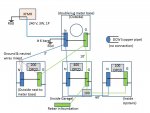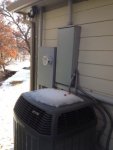a0128958
Member
- Location
- Plano, TX, USA
I'm preparing to install energy monitoring h/w and lighting automation into a large residence in the Dallas area. During an inspection of the existing wiring, shown here:

I've noted a number of things the structure owner I believe needs to correct. Here's my list. Is it complete, and compliant with 2014 Code? And, have I missed something?
1. Make connection from DCW pipe, within 5' of entering residence, to meter panel ground bus (1/0 wire?).
2. Remove insulated wire from meter ground bus to 200 A ground bus.
3. Remove insulated wire from meter ground bus to 400 A ground bus.
4. Add earth rod and connect to 200 A neutral bus.
5. Move foundation concrete rebar ground connecting insulated wire from 400 A ground bus to 400 A neutral bus; verify wire is #4.
6. Verify size of 3 wires from 400 A meter base to 400 A service panel (should be 400 kcmil?).
7. Remove 100 A svc panel ground bus to neutral bus strap (or replace svc panel with w/ subpanel).
8. Insulate 100 A svc panel neutral bus from panel case (or replace svc panel with subpanel).
9. In 100 A svc panel, make sure all circuit grounds go to ground bus. Same for circuit neutrals - make sure, with no exceptions, that neutrals only go to
neutral bus.
Many thanks.
Best regards,
Bill

I've noted a number of things the structure owner I believe needs to correct. Here's my list. Is it complete, and compliant with 2014 Code? And, have I missed something?
1. Make connection from DCW pipe, within 5' of entering residence, to meter panel ground bus (1/0 wire?).
2. Remove insulated wire from meter ground bus to 200 A ground bus.
3. Remove insulated wire from meter ground bus to 400 A ground bus.
4. Add earth rod and connect to 200 A neutral bus.
5. Move foundation concrete rebar ground connecting insulated wire from 400 A ground bus to 400 A neutral bus; verify wire is #4.
6. Verify size of 3 wires from 400 A meter base to 400 A service panel (should be 400 kcmil?).
7. Remove 100 A svc panel ground bus to neutral bus strap (or replace svc panel with w/ subpanel).
8. Insulate 100 A svc panel neutral bus from panel case (or replace svc panel with subpanel).
9. In 100 A svc panel, make sure all circuit grounds go to ground bus. Same for circuit neutrals - make sure, with no exceptions, that neutrals only go to
neutral bus.
Many thanks.
Best regards,
Bill




